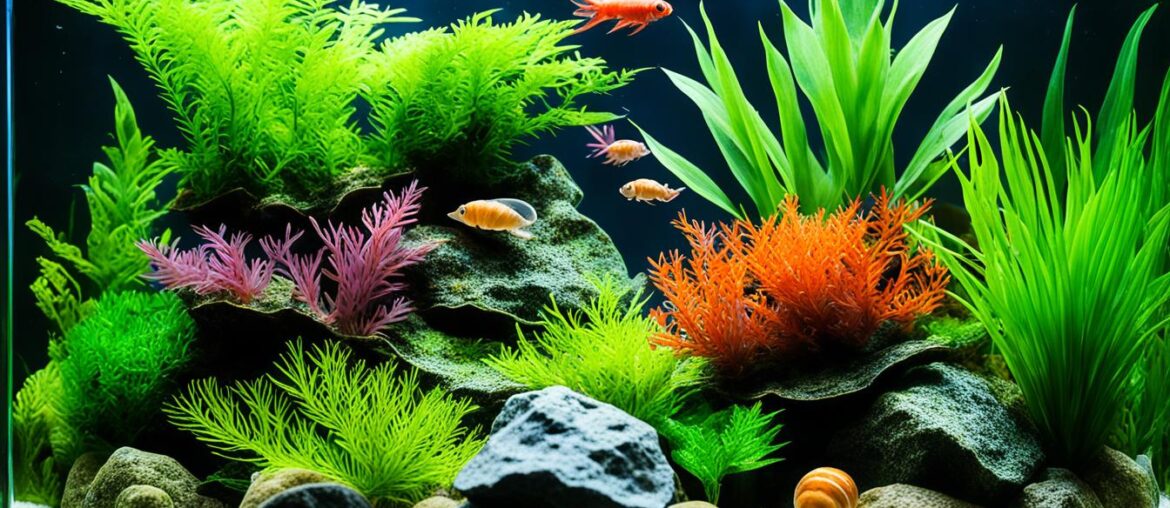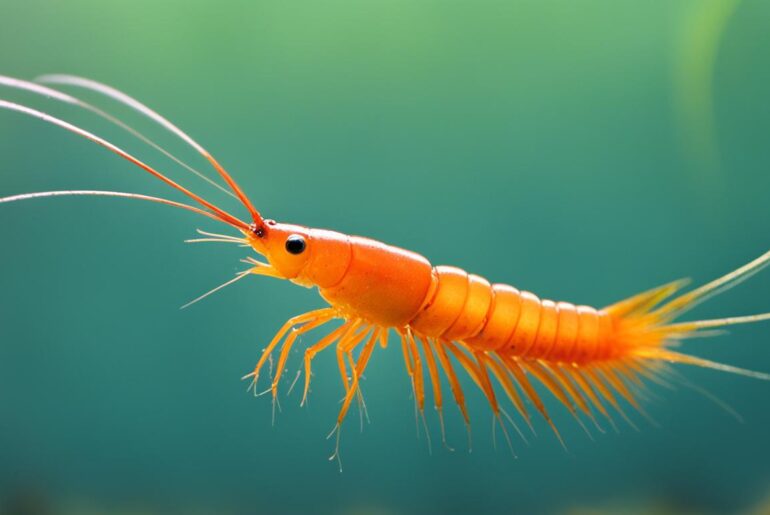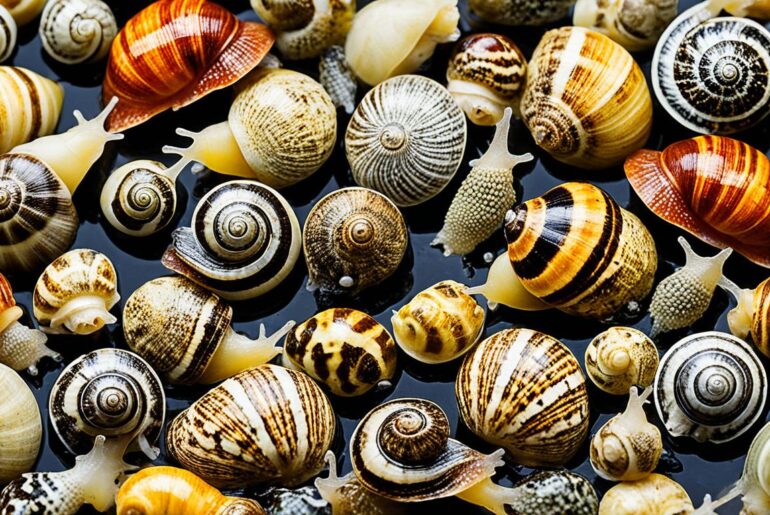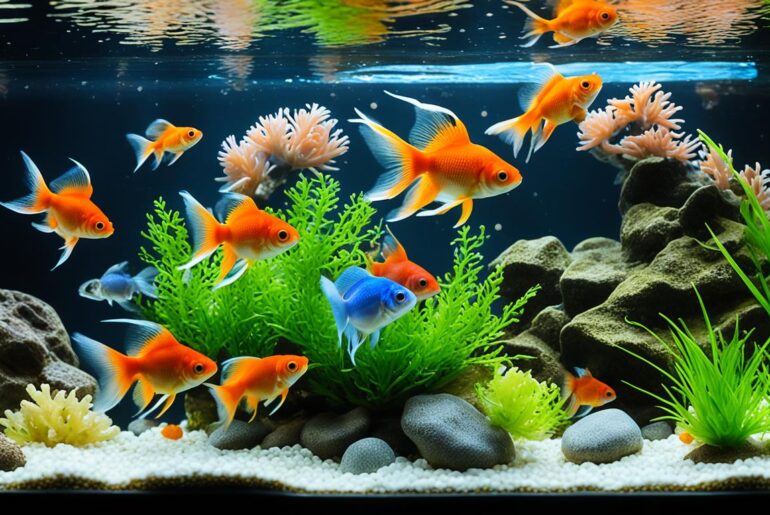Are you an aquarium enthusiast looking to embark on a creative DIY project? Have you ever considered designing and setting up your own freshwater invertebrate habitat? Imagine creating a unique environment that is tailored to the needs of these fascinating creatures. But where do you start? How do you ensure their well-being? Join me as I unveil the 10 essential steps to DIY your own freshwater invertebrate habitat, and discover a world of possibilities that will leave you inspired and amazed.
Key Takeaways:
- Creating a DIY freshwater invertebrate habitat can be a rewarding and fulfilling project.
- Choosing the right tank and equipment is crucial for the success of your habitat.
- Thorough research on invertebrate species will help you create the ideal environment.
- Planning the habitat design with plants, rocks, and decorations is essential for mimicking their natural habitat.
- Maintaining proper water chemistry is crucial for the health of your invertebrates.
Choose the Right Tank and Equipment
When embarking on your DIY freshwater invertebrate habitat project, selecting the right tank and equipment is crucial for the success and well-being of your aquatic inhabitants.
Start by considering the size and shape of the tank based on the number and type of invertebrates you plan to keep. Each species has different space requirements, so be sure to provide enough room for their growth and movement.
Next, gather all the necessary equipment to create a comfortable and suitable environment for your invertebrates. Here are some essential items to include:
- Filter: A proper filtration system helps maintain clean and healthy water by removing impurities and keeping ammonia and nitrate levels in check.
- Heater: Most freshwater invertebrates thrive in specific temperature ranges, so investing in a reliable heater is essential to provide a stable and optimal environment.
- Substrate: Choose a substrate that suits the needs of your invertebrates. Some species prefer sandy substrates, while others may thrive in gravel or planted substrates.
- Lighting: Adequate lighting is important for both the growth of live plants and the overall aesthetic appeal of your habitat.
By ensuring you have the right tank size and all the necessary equipment, you set the foundation for the ideal environment for your freshwater invertebrates to thrive.
Research the Invertebrate Species
Before embarking on your DIY freshwater invertebrate habitat project, it’s essential to conduct thorough research on the specific freshwater invertebrate species you plan to keep. Understanding their unique habitat requirements, water parameters, and compatibility with other species will enable you to create an optimal environment that promotes their well-being and longevity.
Start by identifying the freshwater invertebrate species that capture your interest. Common examples include freshwater shrimp, snails, and crayfish. Once you have chosen the species, delve into their natural habitats and behavior patterns. Take note of the following:
- The water temperature and pH levels preferred by the species
- Their dietary preferences and nutritional needs
- The type of substrate and decorations that mimic their natural environment
- Their compatibility with other species, as some may be territorial or aggressive
Gaining this knowledge is crucial for setting up a suitable habitat that mirrors the conditions necessary for their optimal health and development.
Researching the invertebrate species not only helps you understand their specific needs but also allows you to provide a rich and stimulating environment that supports their natural behaviors and instincts.
Take your time exploring reputable sources such as aquarium literature, online forums, and expert advice from experienced aquarists. Additionally, consult with knowledgeable staff at your local pet store or aquarium society to get valuable insights and recommendations.
By conducting thorough research on your chosen freshwater invertebrate species, you’ll be equipped with the knowledge needed to create an ideal habitat that promotes their overall well-being and allows you to witness their fascinating behaviors.
I know that taking the time to learn about the specific needs of freshwater invertebrates will ensure a successful and fulfilling invertebrate tank setup.
Necessary Information to Research:
| Research Areas | Key Information |
|---|---|
| Water Parameters | Preferred temperature and pH levels |
| Habitat Requirements | Substrate and decoration preferences |
| Feeding Habits | Dietary preferences and nutritional needs |
| Compatibility | Interactions with other species |
Through diligent research, you will gain a comprehensive understanding of the freshwater invertebrate species you plan to keep, allowing you to create a thriving and harmonious aquatic habitat.
Plan the Habitat Design
Now that I have gathered all the necessary information about my chosen invertebrate species, it’s time to plan the design of my habitat. Creating a habitat that mimics their natural environment is key to ensuring their well-being and happiness. Here are some creative aquarium ideas for designing an invertebrate habitat:
Create a Natural-Looking Environment
One of the first things I consider is the types of plants, rocks, and decorations that will mimic the natural habitat of my invertebrates. Adding live plants not only enhances the aesthetic appeal but also provides hiding spots and oxygen for my aquatic friends. I carefully select plants and decor that are compatible with my chosen species, ensuring a beautiful and harmonious environment.
I also pay attention to the placement of rocks and decorations to create hiding spots and territories for my invertebrates. By carefully arranging these elements, I provide them with a sense of security and privacy, allowing them to exhibit their natural behaviors.
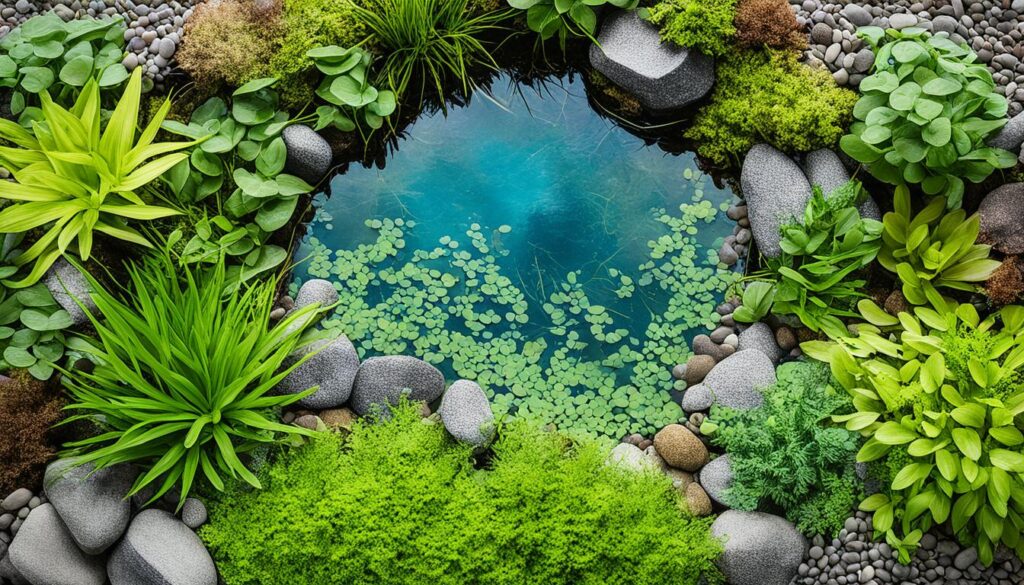
Provide Ample Space for Exploration
It’s important to provide enough space for my invertebrates to explore and thrive. I consider the size and layout of the tank, ensuring it offers plenty of swimming and crawling room. By providing a well-designed habitat, I enable my invertebrates to exhibit their natural behaviors and create an engaging and dynamic environment.
Consider Water Flow and Filtration
Water flow is another crucial aspect to consider when designing an invertebrate habitat. Some species thrive in calmer waters, while others prefer a gentle current. Understanding the needs of my chosen species helps me select the right filtration system and adjust water flow accordingly. By ensuring proper water circulation and filtration, I maintain water quality and create a healthy environment for my invertebrates.
Create a Safe and Stress-Free Environment
While designing the habitat, I prioritize the safety and well-being of my invertebrates. I avoid sharp edges or rough surfaces that could harm them. Additionally, I pay attention to the placement of decorations and equipment to prevent any potential traps or obstacles. A stress-free environment promotes the natural behavior, feeding, and breeding of my invertebrates.
By carefully planning the design of my invertebrate habitat, I can create a visually appealing and functional space for my aquatic friends. The right combination of plants, decorations, and space allows them to thrive and exhibit their natural behaviors. With these creative aquarium ideas, I’m excited to create an invertebrate habitat that provides a stimulating and beautiful home for my aquatic friends.
Establish a Proper Water Chemistry
Maintaining proper water chemistry is crucial for the health and well-being of your freshwater invertebrates. By ensuring that the water parameters are suitable for your specific invertebrate species, you can create an environment that promotes their growth and vitality. Testing the water regularly and adjusting any parameters that are out of range will help you maintain a stable and healthy aquarium ecosystem.
Water Temperature: Invertebrates have specific temperature requirements, so it’s important to keep the water within the recommended range. Use a reliable aquarium thermometer to monitor the temperature and make any necessary adjustments.
pH Level: Different invertebrate species prefer different pH levels, so it’s crucial to establish and maintain the appropriate pH range. Test the water regularly using a pH testing kit and adjust it as needed to create the ideal conditions for your invertebrates.
Ammonia and Nitrate Levels: In a closed aquatic environment, ammonia and nitrate can build up and become harmful to your invertebrates. Monitor these levels using appropriate testing kits and take prompt action if they are above the recommended thresholds. Regular water changes and the use of natural filtration methods, such as live plants and beneficial bacteria, can help maintain optimal water quality.
By establishing a proper water chemistry and ensuring that the temperature, pH level, and ammonia/nitrate levels are suitable for your freshwater invertebrates, you are creating an environment that promotes their health and longevity. Remember to test the water regularly and make any necessary adjustments to keep your invertebrates thriving.
When it comes to creating a visually appealing and stimulating habitat for your freshwater invertebrates, the choice of decor plays a crucial role. By selecting the right freshwater tank decor, you can enhance the aesthetic appeal of your aquarium while also providing functional benefits for your invertebrates. Here are some key considerations when designing the decor for your invertebrate habitat:
- Choose decor that mimics the natural habitat of your invertebrates. Research their natural environment and select decor items that resemble their native surroundings.
- Incorporate hiding places and shelters to provide security and refuge for your invertebrates. Rocks, caves, and driftwood can serve as excellent hiding spots.
- Consider the needs and behaviors of your specific invertebrate species. Some may prefer open spaces for swimming, while others thrive in densely planted areas.
- Avoid decor items with sharp edges or rough surfaces that could potentially harm your invertebrates. Smooth surfaces and rounded edges are safer options.
- Balance the aesthetic appeal with the practical aspects of your invertebrate habitat. Make sure there is ample space for your invertebrates to move around and explore.
By carefully selecting and arranging your freshwater tank decor, you can create a visually stunning and functional habitat for your invertebrates. Remember to prioritize the needs and preferences of your specific invertebrate species to ensure their well-being and happiness in their new home.
Introduce Live Plants and Substrate
When designing your DIY freshwater invertebrate habitat, incorporating live plants and selecting the right substrate is essential. Not only do live plants enhance the aesthetic appeal of your aquarium, but they also serve multiple functions that contribute to the overall well-being of your invertebrates.
Firstly, live plants offer natural hiding places for your freshwater invertebrates, allowing them to feel secure and reducing stress levels. Whether it’s a vibrant green carpet of moss or tall, leafy stems, the plants create an environment that closely resembles their natural habitat.
Moreover, live plants play a crucial role in oxygenating the water, helping to maintain a healthy balance for your aquatic friends. As plants photosynthesize, they release oxygen and absorb carbon dioxide, promoting better water quality.
| Benefits of Live Plants |
|---|
| 1. Natural hiding places |
| 2. Oxygenation of water |
| 3. Provides food source |
| 4. Enhances water clarity |
Additionally, live plants contribute to the ecosystem by providing a natural food source for your freshwater invertebrates. Some species, like shrimp, enjoy grazing on the biofilm and algae that grow on plant leaves, while others may nibble on fallen plant matter, assisting in their nutrient intake.
When selecting live plants, it’s essential to choose varieties that are compatible with your specific invertebrate species. Research their specific habitat preferences, lighting requirements, and growth patterns to ensure a successful coexistence.
Alongside live plants, selecting the right substrate is crucial for creating a natural habitat in your freshwater aquarium. The substrate not only anchors the plants but also provides a fertile bed for their roots and a debris-free environment for your invertebrates.
Choose a substrate that promotes plant growth and provides a comfortable habitat for your invertebrates. Depending on your preferences and the needs of your invertebrates, you can opt for sand, gravel, or a nutrient-rich soil-based substrate.
The choice of substrate also depends on the specific plant species you plan to include in your invertebrate habitat. Some plants may require a fine-grained substrate for proper root development, while others may thrive in gravel or sand.
Ultimately, a well-designed combination of live plants and suitable substrate will create a beautiful, natural-looking habitat for your freshwater invertebrates to explore and call home.
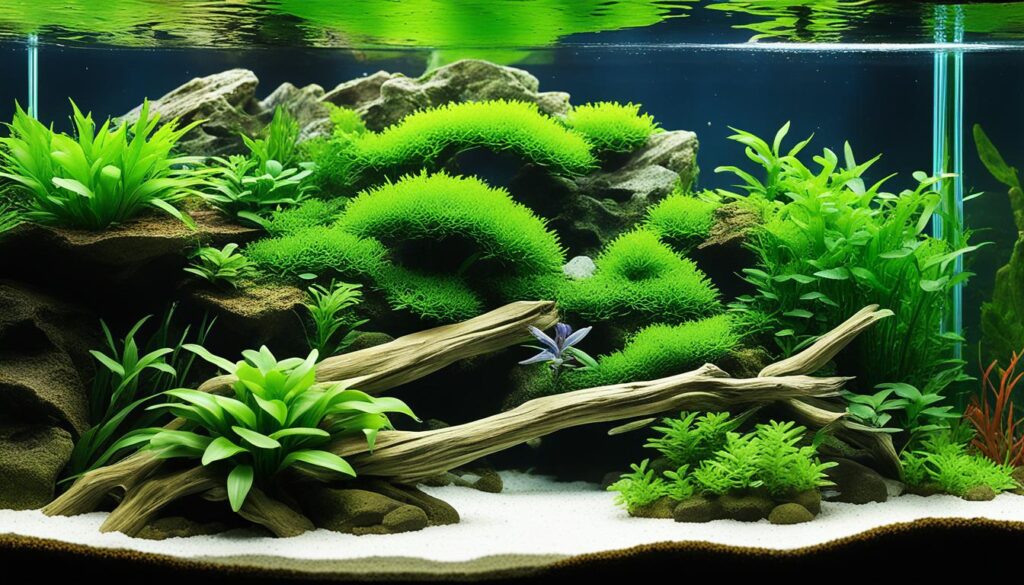
By considering the light and nutrient requirements of your plants and the diverse needs of your invertebrates, you can create a captivating and functional habitat that provides a thriving ecosystem for your freshwater invertebrates.
Acclimate and Introduce the Invertebrates
Once you have set up your DIY freshwater invertebrate habitat, it’s time to acclimate and introduce your invertebrates to their new home. Proper acclimation is essential to ensure a smooth transition and minimize stress for your precious aquatic friends.
To acclimate your invertebrates, follow these steps:
- Float their temporary container in the tank: Gently place the container with your invertebrates into the tank, ensuring that it floats on the surface.
- Gradually add tank water: Over the next 30 to 60 minutes, slowly add small amounts of tank water to the container at regular intervals. This will allow your invertebrates to adjust to the temperature and water chemistry of their new environment.
- Monitor behavior and health: While acclimating your invertebrates, keep a close eye on their behavior and overall health. Look for signs of stress or illness such as sluggishness, unusual swimming patterns, or discoloration.
After the acclimation process, carefully release your invertebrates into the tank. Watch them explore their new habitat and observe their interactions with the environment and other tank inhabitants, if any.
Remember to observe the following guidelines when introducing freshwater invertebrates:
- Handle with care: Always handle your invertebrates with clean, wet hands or use a soft net to transfer them into the tank. Avoid rough handling, as this can cause injury or stress.
- Compatibility: If you have other tank inhabitants, ensure that your chosen freshwater invertebrates are compatible with them. Some species may have specific requirements or may not get along well with certain fish or other invertebrates.
By acclimating and introducing your freshwater invertebrates properly, you can help them adjust to their new surroundings and ensure a successful start in their DIY habitat.
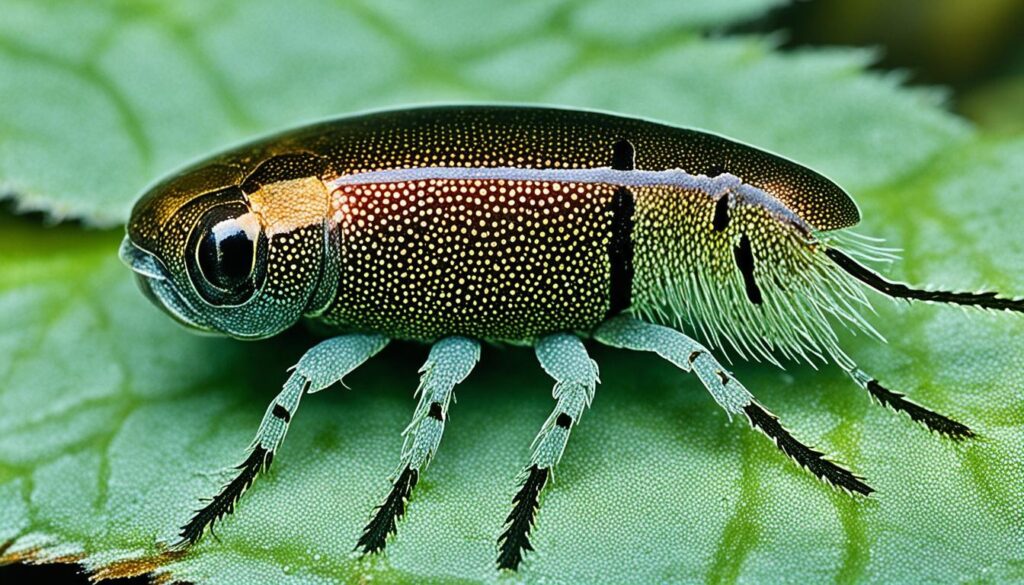
Common Freshwater Invertebrates and Their Acclimation Requirements
| Invertebrate Species | Acclimation Temperature | Acclimation Time |
|---|---|---|
| Cherry Shrimp | ±2°F of tank water | 30-60 minutes |
| Ghost Shrimp | ±2°F of tank water | 30-60 minutes |
| Nerite Snail | ±2°F of tank water | 30-60 minutes |
| Amano Shrimp | ±2°F of tank water | 30-60 minutes |
Acclimation requirements may vary depending on the specific invertebrate species, so it’s important to research and understand their needs before starting the acclimation process.
Maintain Water Quality and Perform Regular Maintenance
To keep your DIY freshwater invertebrate habitat thriving, it’s important to prioritize water quality and perform routine maintenance. By regularly testing the water parameters, cleaning the tank, and performing necessary water changes, you can provide a healthy and stable environment for your invertebrates.
Monitor Water Parameters
Regularly testing the water parameters is essential to ensure that they remain within the appropriate range for your invertebrate tank setup. Here are a few key parameters to monitor:
- Temperature: Maintain a stable temperature suitable for your specific invertebrate species.
- pH Level: Keep the pH level within the recommended range to promote optimal health and well-being.
- Ammonia/Nitrate Levels: Monitor and control the levels of ammonia and nitrate to prevent any harmful effects on your invertebrates.
Investing in a reliable water testing kit will simplify the process of monitoring these parameters and allow you to take prompt action if any issues arise.
Clean the Tank
Regular tank maintenance involves cleaning various components of the tank to remove debris, excess food, and waste. Here are some essential tasks to include in your cleaning routine:
- Algae Removal: Control algae growth by cleaning the tank walls and decorations regularly.
- Gravel Vacuuming: Use a gravel vacuum to remove debris and accumulated waste from the substrate.
- Filter Maintenance: Clean or replace filter media as necessary to maintain adequate filtration.
Regular cleaning will help prevent water quality issues and promote the overall well-being of your invertebrates.
Perform Water Changes
Regular water changes are crucial to maintain a healthy aquatic environment for your freshwater invertebrates. Regularly replacing a portion of the water helps remove accumulated toxins and replenish essential minerals. The frequency and volume of water changes depend on factors such as tank size, stocking density, and water quality. As a general guideline, aim for a 10-20% water change every 1-2 weeks.
Address Issues Promptly
Closely monitor your invertebrates for any signs of stress, illness, or abnormalities. If you notice any issues, take immediate action to address them. Consult reputable sources or seek advice from knowledgeable aquarium professionals to ensure the health and well-being of your invertebrates.
Remember, maintaining water quality and performing regular maintenance are essential aspects of caring for your DIY freshwater invertebrate habitat. By prioritizing these tasks, you can create a thriving environment that supports the long-term health and enjoyment of your invertebrates.
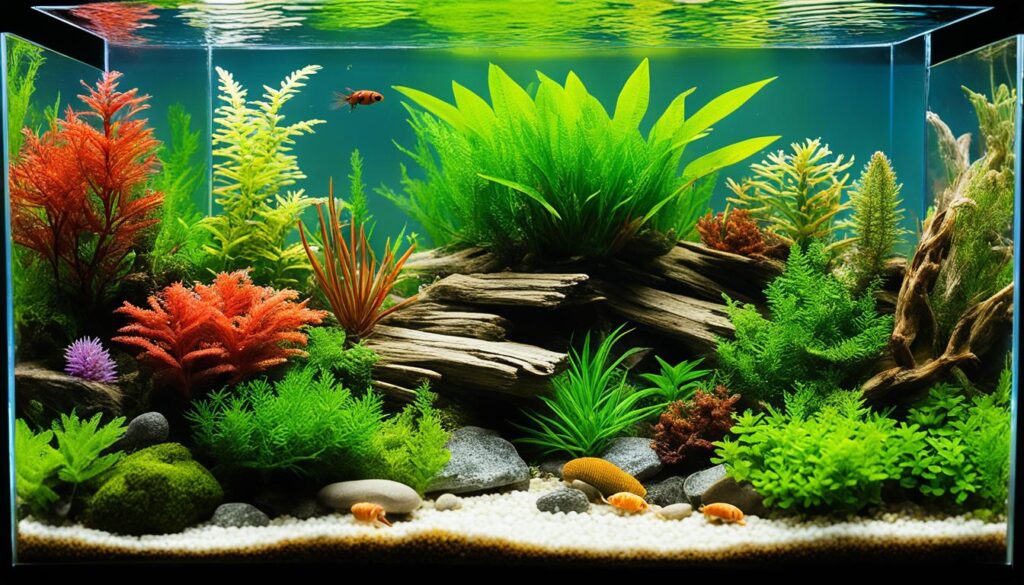
| Key Tasks | Frequency |
|---|---|
| Test water parameters | Weekly |
| Clean tank walls and decorations | Every 2-3 weeks |
| Gravel vacuuming | Monthly |
| Filter maintenance | As needed |
| Perform water changes | Every 1-2 weeks |
Feed and Provide Enrichment for Your Invertebrates
When it comes to caring for your DIY aquatic habitat and ensuring the well-being of your freshwater invertebrates, providing a varied and balanced diet is essential. Each species has unique dietary needs, so it’s important to research and understand what your specific invertebrates require for optimal health.
Offer a mix of live, frozen, and dry foods to provide a well-rounded and nutritious diet. Live foods, such as brine shrimp or daphnia, can be a great source of enrichment and mimic the natural feeding behaviors of your invertebrates.
Consider using interactive feeding devices, like feeding rings or puzzles, to stimulate natural foraging and reduce competition for food. These enrichment activities can help keep your invertebrates active and engaged.
Placing food in different areas of the tank can encourage exploration and mimic the foraging experience in the wild. This can be achieved by anchoring food to specific locations or using feeding stations.
Example Enrichment Activities for Freshwater Invertebrates:
- Create a feeding ring using a suction cup and plastic tubing to keep floating foods contained in one area.
- Use a mesh bag to secure vegetables like blanched zucchini or spinach, providing a source of additional nutrients.
- Provide a clean, empty snail shell as an interactive enrichment toy. Place food inside the shell and watch your invertebrates explore and discover their meal.
Remember to observe your invertebrates during feeding time to ensure they are consuming the appropriate amount of food. Adjust your feeding routine as needed to maintain a balanced diet.
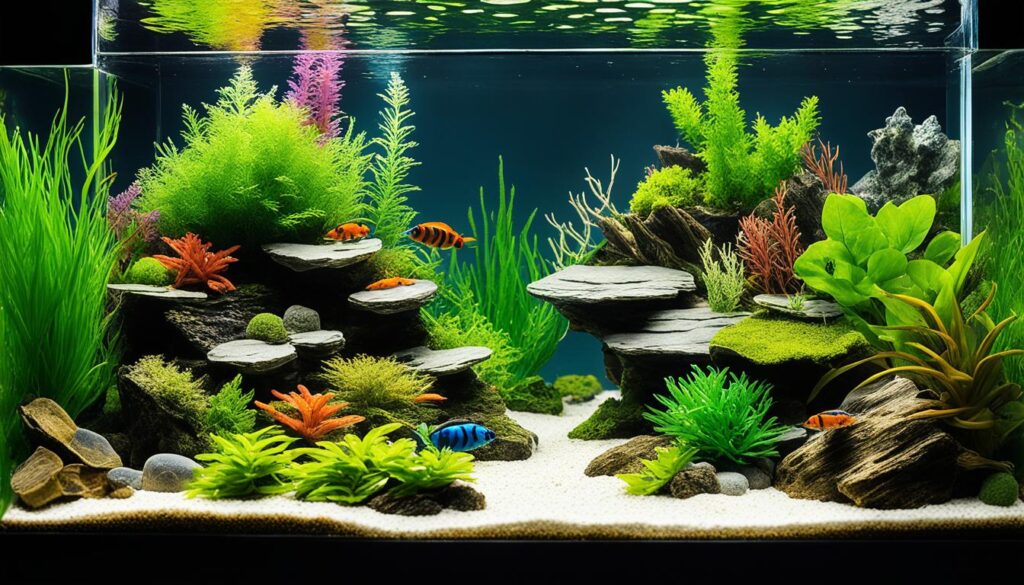
| Live Foods | Frozen Foods | Dry Foods |
|---|---|---|
| Daphnia | Bloodworms | Flake food |
| Brine shrimp | Mysis shrimp | Pellets |
| Infusoria | Cyclops | Sinking tablets |
Monitor and Observe Your Invertebrates
As an aquarium enthusiast, it’s important to regularly monitor and observe your freshwater invertebrates. By paying close attention to their behavior, feeding habits, and overall health, you can ensure their well-being and quickly identify any potential issues. This hands-on approach allows you to take the necessary actions to maintain a healthy and thriving invertebrate tank setup.
One of the key aspects to monitor is the behavior of your invertebrates. Observe how they interact with each other and their surroundings. Are they swimming or crawling as usual? Are they hiding more than usual? These observations can give you insights into their comfort level and overall health.
Feeding habits are also important to monitor. Keep an eye on how your invertebrates consume their food. Are they eating enthusiastically or showing a lack of appetite? Any changes in their feeding behavior could be a sign of stress or health issues.
Closely observing your invertebrates allows you to identify any potential issues early on and take appropriate actions to ensure their well-being.
Regular observation also gives you the opportunity to spot any physical changes or abnormalities in your invertebrates. Keep a lookout for signs of disease or injury, such as discoloration, lesions, or unusual growths. Addressing these issues promptly can prevent further complications and help your invertebrates recover.
Remember to maintain a detailed record of your observations. Use a journal or digital spreadsheet to document any notable behaviors, feeding patterns, or physical changes. This record will serve as a valuable reference and aid in tracking the progress and overall health of your freshwater invertebrates.
By monitoring and observing your invertebrates regularly, you not only ensure their well-being but also deepen your connection and understanding of these fascinating creatures. Take the time to appreciate their beauty and marvel at their unique behaviors. Your invertebrate tank setup will thrive with your attentive care.

Conclusion
Creating your own DIY freshwater invertebrate habitat is a fantastic way to provide a one-of-a-kind and stimulating environment for your aquatic friends. By following the 10 steps outlined above, you can design and set up a habitat that caters to the specific needs of your chosen invertebrate species. Whether you’re a beginner or an experienced aquarium enthusiast, this DIY project offers endless opportunities to showcase your creativity and passion for these fascinating creatures.
Researching your invertebrate species and understanding their habitat requirements is crucial to ensure the success of your DIY project. By planning and designing the habitat to mimic their natural environment, you can create a space where your invertebrates can thrive and express their natural behaviors.
Once your DIY habitat is established, it’s essential to maintain a stable and healthy environment. Regularly monitor water quality, perform routine maintenance, and provide a balanced diet for your invertebrates. By taking these steps, you’ll enjoy the long-term health and enjoyment of your freshwater invertebrates.
So, roll up your sleeves and dive into the world of DIY freshwater invertebrate habitats! With a little creativity, research, and dedication, you can create an enchanting aquatic ecosystem for your invertebrates that will provide hours of joy and fascination.
FAQ
What size tank should I choose for my freshwater invertebrates?
The tank size should be based on the number and type of invertebrates you plan to keep. Ensure that the tank provides enough space for their growth and survival.
What equipment do I need for my DIY freshwater invertebrate habitat?
You will need a filter, heater, substrate, and lighting to create a comfortable environment for your invertebrates.
How do I research the specific freshwater invertebrate species I want to keep?
Look up their habitat requirements, water parameters, and compatibility with other species to create the ideal environment for your invertebrates.
How do I plan the design of my freshwater invertebrate habitat?
Consider the types of plants, rocks, and decorations that mimic their natural habitat. Create hiding spots and provide ample space for your invertebrates to explore and thrive.
What is the importance of water chemistry in my invertebrate habitat?
Proper water chemistry is crucial for the health of your invertebrates. Monitor and adjust parameters such as temperature, pH level, and ammonia/nitrate levels to ensure they are suitable for your specific invertebrate species.
Should I include live plants in my freshwater invertebrate habitat?
Yes, live plants enhance the aesthetic appeal and provide hiding places, oxygen, and food for your invertebrates. Choose aquatic plants that are compatible with your invertebrate species.
How do I acclimate my invertebrates to the new habitat?
Slowly introduce them to the tank’s water conditions by floating their temporary container in the tank and gradually adding small amounts of tank water.
How do I maintain water quality in my DIY invertebrate habitat?
Regularly test the water parameters, clean the tank, and perform water changes as necessary. Address any signs of stress or illness in your invertebrates promptly.
What should I feed my freshwater invertebrates?
Research the specific dietary needs of your chosen species and offer a mix of live, frozen, and dry foods to ensure a nutritious diet. Consider providing enrichment activities to stimulate natural feeding behaviors.
How do I monitor the health of my freshwater invertebrates?
Observe their behavior, feeding habits, and overall health regularly to identify any potential issues early on and take appropriate actions.
